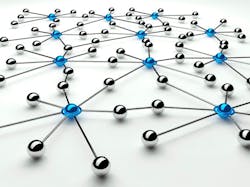Internet of Things discussed at Plumbing Industry Leadership Coalition meeting
WASHINGTON — Now that everything can be connected, everything will be. The future isn’t about the communicating sensors that will be inside every object, but about what we will do with the information that comes out of the data.
For example, most American cities have leaky water supply pipes. While it’s not practical to catch all of them, it’s possible to find the most significant leaks. Mueller Water Products, IBM and AT&T have teamed up to create a system that tracks water pressure, temperature and leaks. The systems have been deployed on a trial basis in Las Vegas, Los Angeles and Atlanta, reported realstreettech.com.
The venture is part of the Global Cities Team Challenge created by the National Institutes of Standards and Technology. The website’s story quotes Dr. Sokwoo Rhee, NIST’s associate director of cyber-physical systems programs.
Dr. Rhee also addressed the Internet of Things at this year’s meeting of the Plumbing Industry Leadership Coalition that met here in mid-May.
PILC is composed of the top executives and top elected leaders of the industry’s membership-based associations, including Plumbing-Heating-Cooling Contractors – National Association, Mechanical Contractors Association of America, Plumbing Manufacturers International, American Society of Plumbing Engineers and the International Association of Plumbing & Mechanical Officials, among others.
Dr. Rhee said that IoT is analogous to putting building automation systems into commercial buildings 20 years ago. The BAS has sensors and controllers all over the building communicating with each other. The difference now is that the sensors are everywhere.
“You get big data from sensors and other sources and crunch it,” Dr. Rhee said. “That’s where the sensors are playing a role, and what’s important is how do you extract information out of all this data?”
Streamlining operations: safety reporting and sharing of photos
Dr. Rhee works in NIST’s cyber-physical systems program, but what are cyber-physical systems? They are sensors, actuators, anything that you can imagine in a smart system, Dr. Rhee explained, including unmanned vehicles, robots, control networking, manufacturing systems, electric utilities’ smart grid, network-enabled healthcare systems, or machine-to-machine communications. It’s where you take a physical object and connect it with cyber systems.
The purpose is to come up with some kind of service, he said. You extract data, perform data analytics, and use that information to create a service that you couldn’t do before.
NIST created the Smart America Challenge and the Global Cities Team Challenge, to nurture cross-sector collaboration to demonstrate measurable impacts on job creation and new business opportunities (NIST is, after all, a part of the Department of Commerce).
The result was 100 organizations formed 24 teams to investigate different problems for which IoT could be part of the solution. Starting in 2014, NIST brought together stakeholders that include the National Sanitation Foundation, the International Trade Administration, the Department of Energy, Health and Human Services, and corporations like IBM, Qualcomm, AT&T, GE, as well as cities from the U.S. and abroad. Amsterdam has always had an interest in partnering with any other city to solve common problems.
Instead of each city working with innovators like businesses and universities, Dr. Rhee noted, why not have multiple cities team up to tackle an issue, such as clean air or clean water? Perhaps some cities already have an ideal solution, so why not share it?
The Army has worked on autonomous vehicles to pick up wounded soldiers. The three aforementioned cities are experimenting with enhanced water distribution infrastructure for conservation, security, and environmental benefits.
Massachusetts General Hospital, the University of California at Irvine and Schneider Electric are working on healthcare-related communications with elderly and low-income families. A lot of people die because they fall and can’t get up, Dr. Rhee explained, so if you can detect that and call 911, it can save a lot of people.
What if sensors were put in the smoke detectors that can detect a fall? IBM’s Watson supercomputer is crunching data on this to see how you tell the difference between someone falling down versus just going to bed.
The Global Cities Team Challenge is working on traffic management. Every city has a traffic management system and and all of them are reinventing the wheel. At any one time as many as 30% of cars in New York are circling the block looking for parking. Researchers want to demonstrate a replicable and scalable model.
How should cities address autonomous vehicles? Traffic jams create air pollution, so Portland, Oregon, is working with Intel to measure and improve traffic flow, thereby reducing air pollution.
San Francisco is working with CityZenith, creator of the 5D Smart data platform, to see if they can locate the most energy inefficient buildings in the city, the proverbial low-hanging fruit for energy management improvements.
In natural disasters, the first thing to go down is the cellular network, so what if we could create a smart emergency response system? What if we could create a grid of drones that would establish an ad hoc WiFi network that would last hours or days, long enough for firefighters and other first responders to communicate with each other, with search-and-rescue robots or with the healthcare system?
While infrastructure within cities may be talking to each other, Dr. Rhee was asked if communication with homes would become part of this. Not at this time, he said; there are too many privacy concerns.
About the Author
Robert P. Mader
Bob Mader is the Editorial Director for Penton's mechanical systems brands, including CONTRACTOR magazine, Contracting Business and HPAC Engineering, all of which are part of Penton’s Energy and Buildings Group. He has been with CONTRACTOR since 1984 and with Penton since 2001. His passions are helping contractors improve their businesses, saving energy and the issue of safeguarding our drinking water. He is a graduate of the University of Notre Dame with an A.B. in American Studies with a Communications Concentration.

